Seasonal Variation and Spatial Heterogeneity of Water Quality Parameters in Lake Chenghai in Southwestern China
Abstract
:1. Introduction
2. Data and Methods
2.1. Background of Lake Chenghai
2.2. Sampling
2.3. Analysizing Methods
2.3.1. Comprehensive Nutrition State Index
2.3.2. Lake Quality Level
2.3.3. Correlation Analysis Method
3. Results and Discussion
3.1. Vertical Stratification and Seasonal Temperature Fluctuations
3.2. Seasonal Variation Characteristics of the Water Quality Profile
3.2.1. Dissolved Oxygen (DO)
3.2.2. pH Value
3.2.3. Chlorophyll-a (Chl-a)
3.3. Correlation Analysis of Water Quality in Lake Chenghai
3.4. Limitations and Implications
4. Conclusions
Author Contributions
Funding
Data Availability Statement
Acknowledgments
Conflicts of Interest
References
- Lu, Y.; Wang, R.; Zhang, Y.; Su, H.; Wang, P.; Jenkins, A.; Ferrier, R.C.; Bailey, M.; Squire, G. Ecosystem health towards sustainability. Ecosyst. Health Sustain. 2015, 1, 1–15. [Google Scholar] [CrossRef]
- Paerl, H.W.; Paul, V.J. Climate change: Links to global expansion of harmful cyanobacteria. Water Res. 2012, 46, 1349–1363. [Google Scholar] [CrossRef] [PubMed]
- Bruesewitz, D.A.; Carey, C.C.; Richardson, D.C.; Weathers, K.C. Under-ice thermal stratification dynamics of a large, deep lake revealed by high-frequency data. Limnol. Oceanogr. 2015, 60, 347–359. [Google Scholar] [CrossRef]
- Zhang, Y.; Wu, Z.; Liu, M.; He, J.; Shi, K.; Zhou, Y.; Wang, M.; Liu, X. Dissolved oxygen stratification and response to thermal structure and long-term climate change in a large and deep subtropical reservoir (Lake Qiandaohu, China). Water Res. 2015, 75, 249–258. [Google Scholar] [CrossRef] [PubMed]
- Alexakis, D.; Kagalou, I.; Tsakiris, G. Assessment of pressures and impacts on surface water bodies of the Mediterranean. Case study: Pamvotis Lake, Greece. Environ. Earth Sci. 2013, 70, 687–698. [Google Scholar] [CrossRef]
- Kraemer, B.M.; Anneville, O.; Chandra, S.; Dix, M.; Kuusisto, E.; Livingstone, D.M.; Rimmer, A.; Schladow, S.G.; Silow, E.; Sitoki, L.M.; et al. Morphometry and average temperature affect lake stratification responses to climate change. Geophys. Res. Lett. 2015, 42, 4981–4988. [Google Scholar] [CrossRef] [Green Version]
- Alexakis, D.; Tsihrintzis, V.A.; Tsakiris, G.; Gikas, G.D. Suitability of Water Quality Indices for Application in Lakes in the Mediterranean. Water Resour. Manag. 2016, 30, 1621–1633. [Google Scholar] [CrossRef]
- Butcher, J.B.; Nover, D.; Johnson, T.E.; Clark, C.M. Sensitivity of lake thermal and mixing dynamics to climate change. Clim. Chang. 2015, 129, 295–305. [Google Scholar] [CrossRef] [Green Version]
- Foley, B.; Jones, I.D.; Maberly, S.C.; Rippey, B. Long-term changes in oxygen depletion in a small temperate lake: Effects of climate change and eutrophication. Freshw. Biol. 2012, 57, 278–289. [Google Scholar] [CrossRef]
- Magee, M.R.; Wu, C.H. Response of water temperatures and stratification to changing climate in three lakes with different morphometry. Hydrol. Earth Syst. Sci. 2017, 21, 6253–6274. [Google Scholar] [CrossRef] [Green Version]
- Zou, R.; Zhang, X.; Liu, Y.; Chen, X.; Zhao, L.; Zhu, X.; He, B.; Guo, H. Uncertainty-based analysis on water quality response to water diversions for Lake Chenghai: A multiple-pattern inverse modeling approach. J. Hydrol. 2014, 514, 1–14. [Google Scholar] [CrossRef]
- Liu, X.; Lu, X.; Chen, Y. The effects of temperature and nutrient ratios on Microcystis blooms in Lake Taihu, China: An 11-year investigation. Harmful Algae 2011, 10, 337–343. [Google Scholar] [CrossRef]
- Leach, T.H.; Beisner, B.E.; Carey, C.C.; Pernica, P.; Rose, K.C.; Huot, Y.; Brentrup, J.A.; Domaizon, I.; Grossart, H.-P.; Ibelings, B.W.; et al. Patterns and drivers of deep chlorophyll maxima structure in 100 lakes: The relative importance of light and thermal stratification. Limnol. Oceanogr. 2012, 63, 628–646. [Google Scholar] [CrossRef] [Green Version]
- Zhang, Y.; Wu, Z.; Liu, M.; He, J.; Shi, K.; Wang, M.; Yu, Z. Thermal structure and response to long-term climatic changes in Lake Qiandaohu, a deep subtropical reservoir in China. Limnol. Oceanogr. 2014, 59, 1193–1202. [Google Scholar] [CrossRef]
- Liu, Y.; Wang, Y.; Sheng, H.; Dong, F.; Zou, R.; Zhao, L.; Guo, H.; Zhu, X.; He, B. Quantitative evaluation of lake eutrophication responses under alternative water diversion scenarios: A water quality modeling based statistical analysis approach. Sci. Total Environ. 2014, 468-469, 219–227. [Google Scholar] [CrossRef]
- Zohary, T.; Ostrovsky, I. Ecological impacts of excessive water level fluctuations in stratified freshwater lakes. Inland Waters 2011, 1, 47–59. [Google Scholar] [CrossRef]
- Kirillin, G.; Shatwell, T. Generalized scaling of seasonal thermal stratification in lakes. Earth-Sci. Rev. 2016, 161, 179–190. [Google Scholar] [CrossRef] [Green Version]
- Zhang, L.; Xu, K.; Wang, S.; Wang, S.; Li, Y.; Li, Q.; Meng, Z. Characteristics of dissolved organic nitrogen in overlying water of typical lakes of Yunnan Plateau, China. Ecol. Indic. 2018, 84, 727–737. [Google Scholar] [CrossRef]
- Yang, K.; Yu, Z.; Luo, Y. Analysis on driving factors of lake surface water temperature for major lakes in Yunnan-Guizhou Plateau. Water Res. 2020, 184, 116018. [Google Scholar] [CrossRef]
- Yan, D.; Xu, H.; Yang, M.; Lan, J.; Hou, W.; Wang, F.; Zhang, J.; Zhou, K.; An, Z.; Goldsmith, Y. Responses of cyanobacteria to climate and human activities at Lake Chenghai over the past 100 years. Ecol. Indic. 2019, 104, 755–763. [Google Scholar] [CrossRef]
- Song, Y.; Qi, J.; Deng, L.; Bai, Y.; Liu, H.; Qu, J. Selection of water source for water transfer based on algal growth potential to prevent algal blooms. J. Environ. Sci. 2021, 103, 246–254. [Google Scholar] [CrossRef] [PubMed]
- Yang, K.; Yu, Z.; Luo, Y.; Zhou, X.; Shang, C. Spatial-Temporal Variation of Lake Surface Water Temperature and Its Driving Factors in Yunnan-Guizhou Plateau. Water Resour. Res. 2019, 55, 4688–4703. [Google Scholar] [CrossRef]
- Yu, Y.; Zhang, M.; Qian, S.; Li, D.; Kong, F. Current status and development of water quality of lakes in Yunnan-Guizhou Plateau. J. Lake Sci. 2010, 22, 820–828. [Google Scholar]
- Wan, G.J.; Chen, J.A.; Wu, F.C.; Xu, S.Q.; Bai, Z.G.; Wan, E.Y.; Wang, C.; Huang, R.; Yeager, K.; Santschi, P. Coupling between 210Pbex and organic matter in sediments of a nutrient-enriched lake: An example from Lake Chenghai, China. Chem. Geol. 2005, 224, 223–236. [Google Scholar] [CrossRef]
- Du, L.N.; Jiang, Y.E.; Chen, X.Y.; Yang, J.X.; Aldridge, D. A family-level macroinvertebrate biotic index for ecological assessment of lakes in Yunnan, China. Water Resour. 2017, 44, 864–874. [Google Scholar] [CrossRef]
- Sun, W.; Zhang, E.; Liu, E.; Ji, M.; Chen, R.; Zhao, C.; Shen, J.; Li, Y. Oscillations in the Indian summer monsoon during the Holocene inferred from a stable isotope record from pyrogenic carbon from Lake Chenghai, southwest China. J. Southeast Asian Earth Sci. 2017, 134, 29–36. [Google Scholar] [CrossRef]
- Wu, F.; Xu, L.; Liao, H.; Guo, F.; Zhao, X.; Giesy, J.P. Relationship between mercury and organic carbon in sediment cores from Lakes Qinghai and Chenghai, China. J. Soils Sediments 2013, 13, 1084–1092. [Google Scholar] [CrossRef]
- Zhang, H.; Huo, S.; Yeager, K.M.; Xi, B.; Zhang, J.; He, Z.; Ma, C.; Wu, F. Accumulation of arsenic, mercury and heavy metals in lacustrine sediment in relation to eutrophication: Impacts of sources and climate change. Ecol. Indic. 2018, 93, 771–780. [Google Scholar] [CrossRef]
- Wang, Y.; Peng, J.; Cao, X.; Xu, Y.; Yu, H.; Duan, G.; Qu, J. Isotopic and chemical evidence for nitrate sources and transformation processes in a plateau lake basin in Southwest China. Sci. Total Environ. 2020, 711, 134856. [Google Scholar] [CrossRef]
- Wang, Y.; Tang, Y.; Xu, Y.; Yu, H.; Cao, X.; Duan, G.; Bi, L.; Peng, J. Isotopic dynamics of precipitation and its regional and local drivers in a plateau inland lake basin, Southwest China. Sci. Total Environ. 2021, 763, 143043. [Google Scholar] [CrossRef]
- Yu, H.; Qi, W.; Liu, C.; Yang, L.; Wang, L.; Lv, T.; Peng, J. Different stages of aquatic vegetation succession driven by environmental disturbance in the last 38 years. Water 2019, 11, 1412. [Google Scholar] [CrossRef] [Green Version]
- Liu, W.; Li, S.; Bu, H.; Zhang, Q.; Liu, G. Eutrophication in the Yunnan Plateau lakes: The influence of lake morphology, watershed land use, and socioeconomic factors. Environ. Sci. Pollut. Res. 2012, 19, 858–870. [Google Scholar] [CrossRef] [PubMed]
- Zan, F.; Huo, S.; Xi, B.; Zhang, J.; Liao, H.; Wang, Y.; Yeager, K.M. A 60-year sedimentary record of natural and anthropogenic impacts on Lake Chenghai, China. J. Environ. Sci. 2012, 24, 602–609. [Google Scholar] [CrossRef]
- China Environmental Status Bulletin. 2002. Available online: http://www.mee.gov.cn/ (accessed on 3 May 2003).
- China National Environmental Monitoring Centre. Lake (Reservoir) Eutrophication Evaluation Method and Classification Technical Provisions, 2001; China National Environmental Monitoring Centre: Beijing, China, 2002. [Google Scholar]
- State Environmental Protection Administration (SEPA). GB3838-2002. Environmental Quality Standard for Surface Water; Standards Press: Beijing, China, 2002; pp. 1–8. (In Chinese)
- Podobnik, B.; Stanley, H.E. Detrended cross-correlation analysis: A new method for analyzing two non-stationary time series. Phys. Rev. Lett. 2008, 100, 084102. [Google Scholar] [CrossRef] [PubMed] [Green Version]
- Lei, H.; Junbo, W.; Liping, Z.; Jianting, J.; Yong, W.; Qingfeng, M. Water temperature and characteristics of thermal stratification in Nam Co, Tibet. J. Lake Sci. 2015, 27, 711–718. [Google Scholar] [CrossRef] [Green Version]
- Noori, R.; Ansari, E.; Bhattarai, R.; Tang, Q.; Aradpour, S.; Maghrebi, M.; Haghighi, A.T.; Bengtsson, L.; Kløve, B. Complex dynamics of water quality mixing in a warm mono-mictic reservoir. Sci. Total Environ. 2021, 777, 146097. [Google Scholar] [CrossRef]
- Li, Y.; Tian, L.; Bowen, G.J.; Wu, Q.; Luo, W.; Chen, Y.; Wang, D.; Shao, L.; Cai, Z.; Tao, J. Deep lake water balance by dual water isotopes in Yungui Plateau, southwest China. J. Hydrol. 2021, 593, 125886. [Google Scholar] [CrossRef]
- Yu, Z.; Yang, K.; Luo, Y.; Shang, C.; Zhu, Y. Lake surface water temperature prediction and changing characteristics analysis-A case study of 11 natural lakes in Yunnan-Guizhou Plateau. J. Clean. Prod. 2020, 276, 122689. [Google Scholar] [CrossRef]
- Schwefel, R.; Gaudard, A.; Wüest, A.; Bouffard, D. Effects of climate change on deepwater oxygen and winter mixing in a deep lake (Lake Geneva): Comparing observational findings and modeling. Water Resour. Res. 2016, 52, 8811–8826. [Google Scholar] [CrossRef]
- Missaghi, S.; Hondzo, M.; Herb, W. Prediction of lake water temperature, dissolved oxygen, and fish habitat under changing climate. Clim. Chang. 2017, 141, 747–757. [Google Scholar] [CrossRef]
- Chen, X.; Liu, X.; Peng, W.; Dong, F.; Chen, Q.; Sun, Y.; Wang, R. Hydroclimatic influence on the salinity and water volume of a plateau lake in southwest China. Sci. Total Environ. 2019, 659, 746–755. [Google Scholar] [CrossRef] [PubMed]
- Cao, X.; Wang, Y.; He, J.; Luo, X.; Zheng, Z. Phosphorus mobility among sediments, water and cyanobacteria enhanced by cyanobacteria blooms in eutrophic Lake Dianchi. Environ. Pollut. 2016, 219, 580–587. [Google Scholar] [CrossRef] [PubMed]
- Ni, L.; Li, D.; Su, L.; Xu, J.; Li, S.; Ye, X.; Geng, H.; Wang, P.; Li, Y.; Li, Y.; et al. Effects of algae growth on cadmium remobilization and ecological risk in sediments of Taihu Lake. Chemosphere 2016, 151, 37–44. [Google Scholar] [CrossRef] [PubMed]
- Filazzola, A.; Mahdiyan, O.; Shuvo, A.; Ewins, C.; Moslenko, L.; Sadid, T.; Blagrave, K.; Imrit, M.A.; Gray, D.K.; Quinlan, R.; et al. A database of chlorophyll and water chemistry in freshwater lakes. Sci. Data 2020, 7, 310. [Google Scholar] [CrossRef]
- Pu, J.; Song, K.; Lv, Y.; Liu, G.; Fang, C.; Hou, J.; Wen, Z. Distinguishing Algal Blooms from Aquatic Vegetation in Chinese Lakes Using Sentinel 2 Image. Remote Sens. 2022, 14, 1988. [Google Scholar] [CrossRef]
- Zhang, M.; Yu, Y.; Yang, Z.; Kong, F. Deterministic diversity changes in freshwater phytoplankton in the Yunnan–Guizhou Plateau lakes in China. Ecol. Indic. 2016, 63, 273–281. [Google Scholar] [CrossRef]
- Zhou, Q.; Wang, W.; Huang, L.; Zhang, Y.; Qin, J.; Li, K.; Chen, L. Spatial and temporal variability in water transparency in Yunnan Plateau lakes, China. Aquat. Sci. 2019, 81, 36. [Google Scholar] [CrossRef]
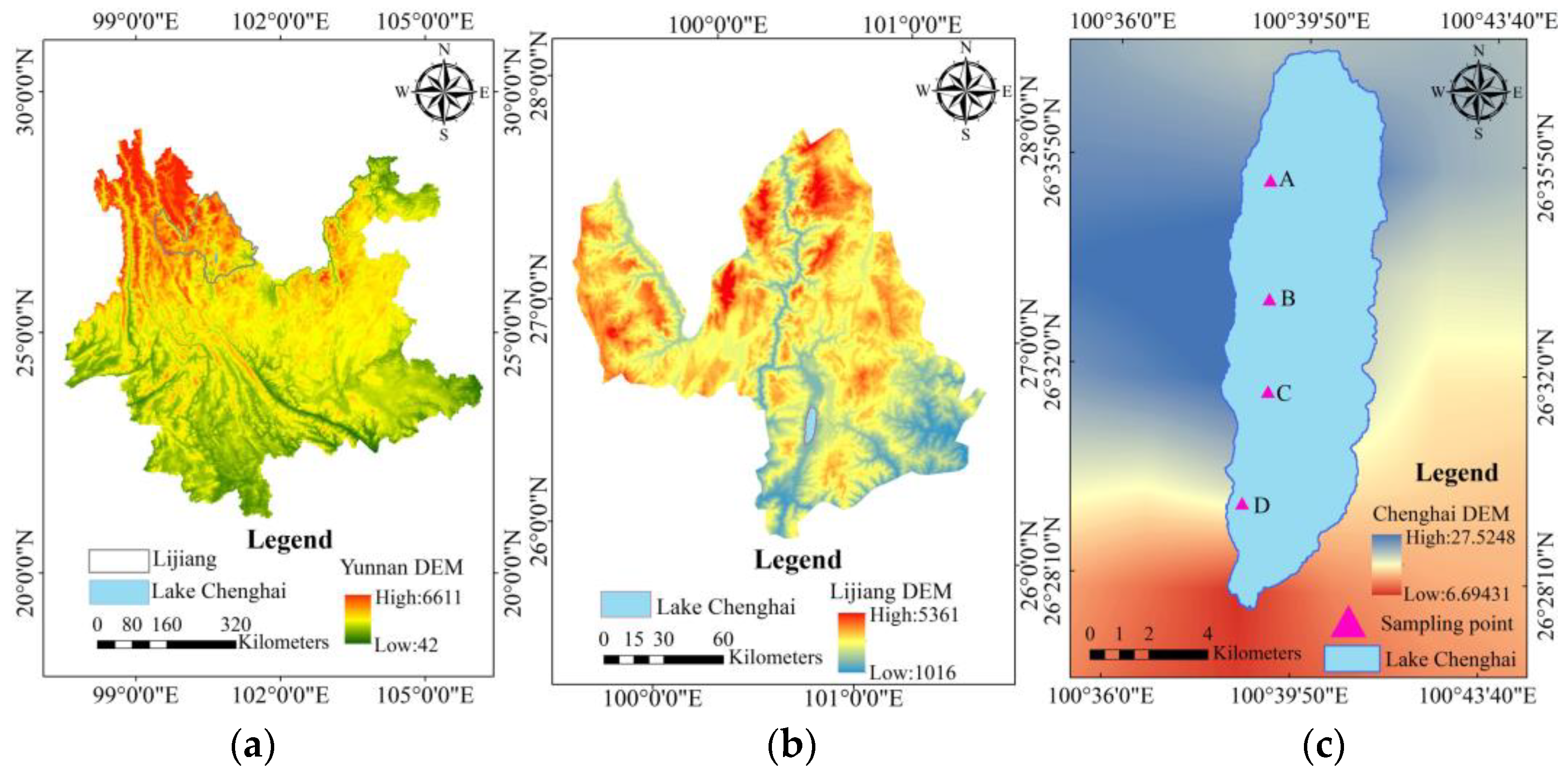

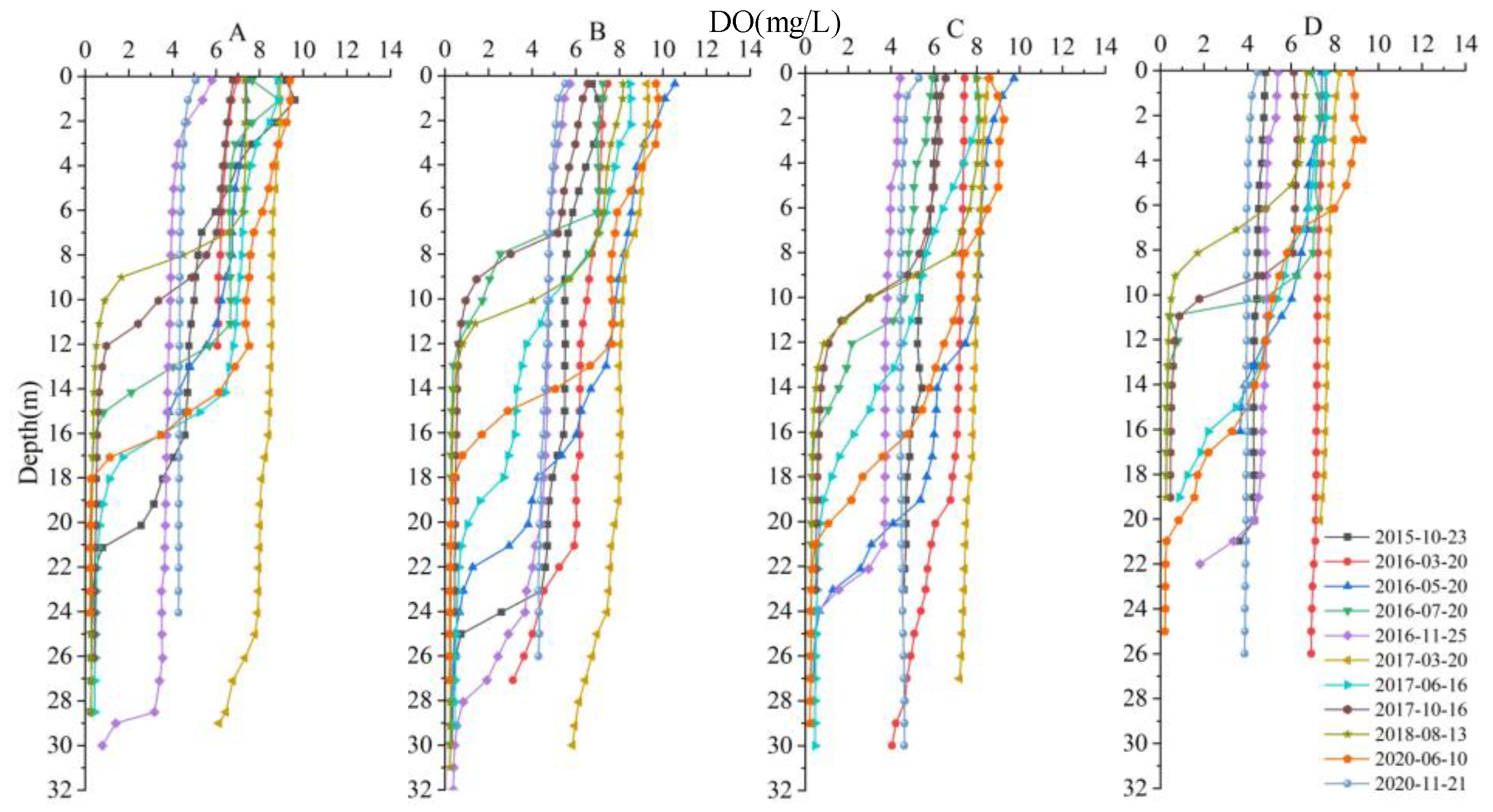
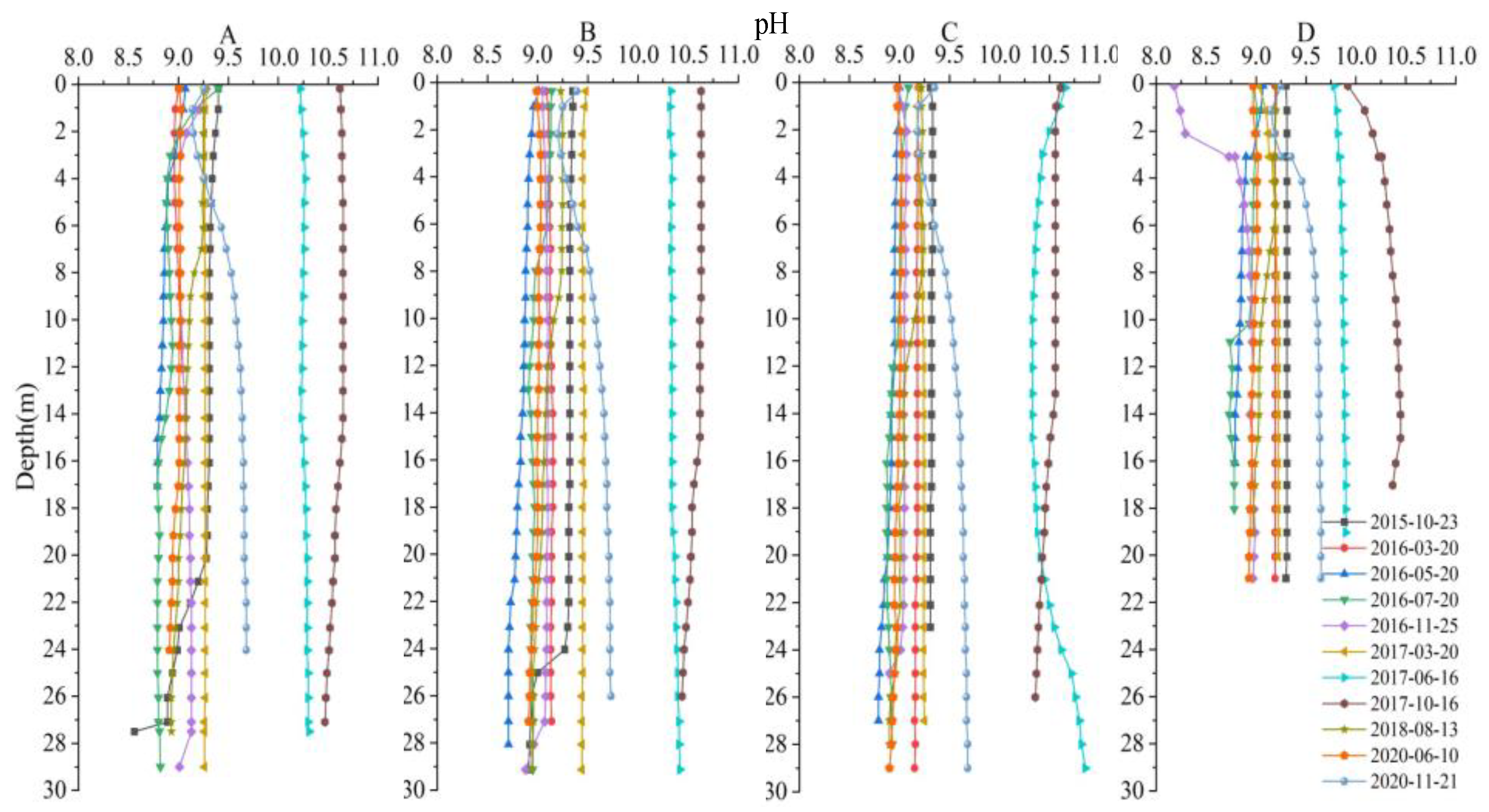
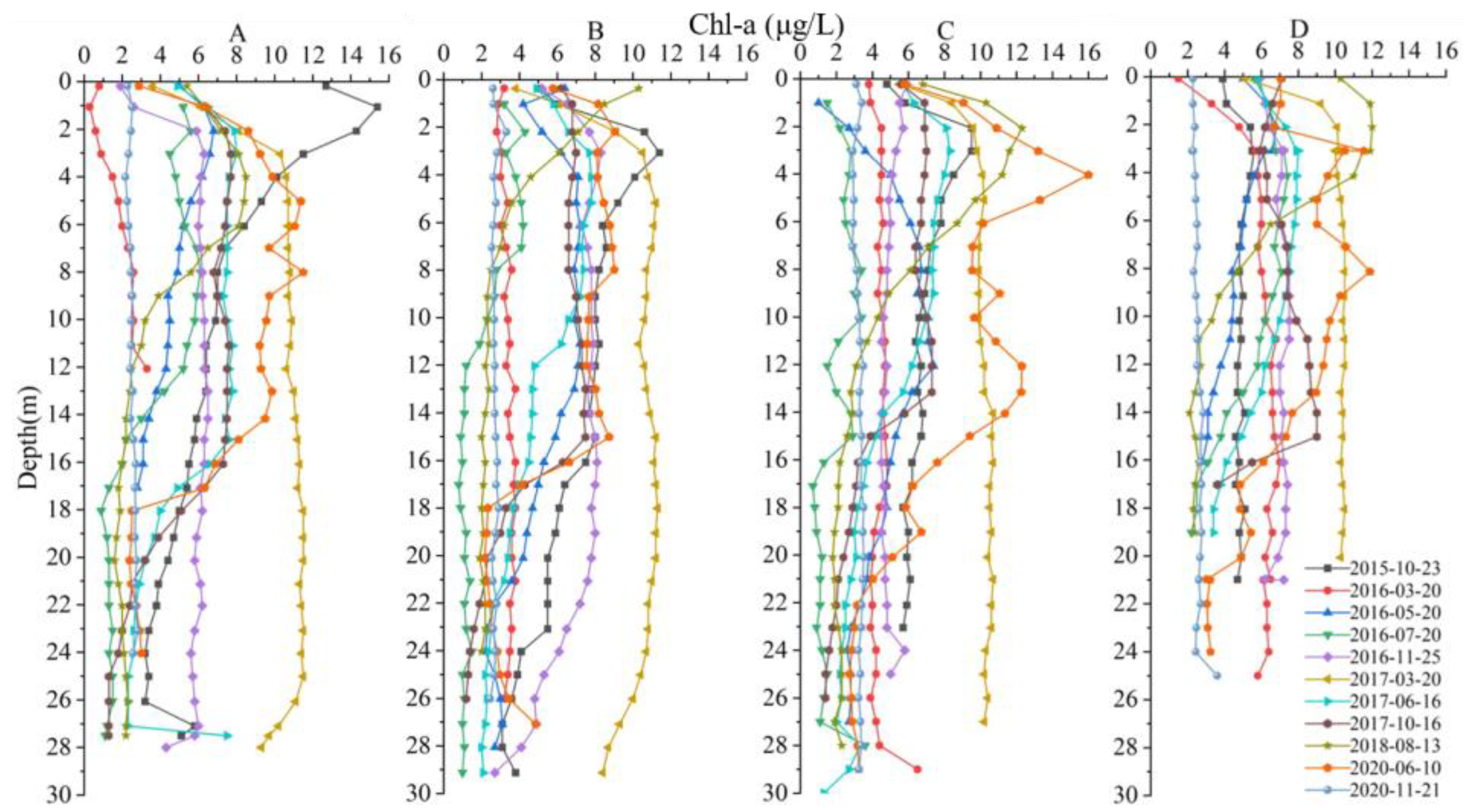
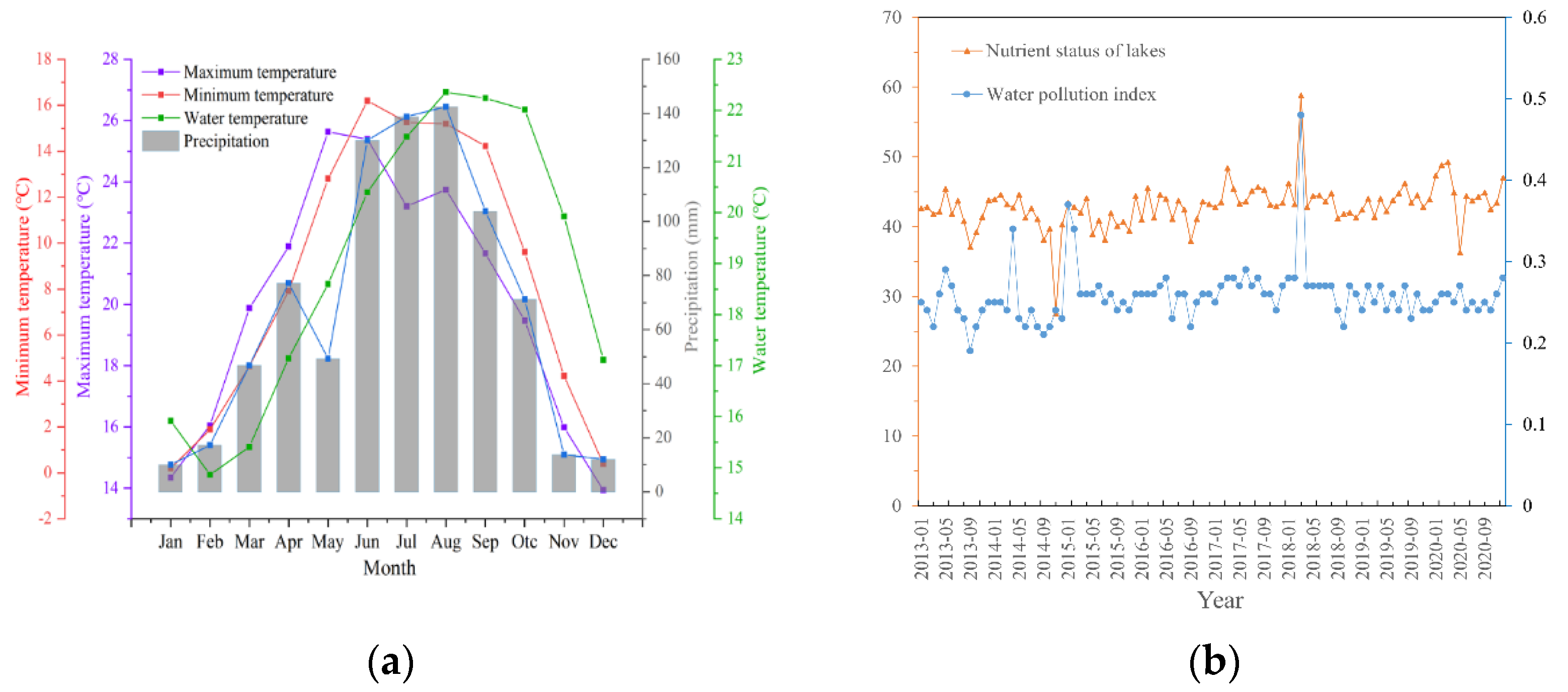
| Parameter | Chl-a | TP | TN | SD | CODMn |
|---|---|---|---|---|---|
| 1 | 0.84 | 0.82 | −0.83 | 0.83 | |
| 1 | 0.7056 | 0.6724 | 0.6889 | 0.6889 |
| Water Quality Classification | Scope of Application |
|---|---|
| Class I | Mainly applicable to source waters and national nature reserves. |
| Class II | Mainly applicable to centralized drinking water, surface water sources, first-class protected areas, etc. |
| Class III | Mainly applicable to secondary protection zones, fisheries, and swimming areas of centralized drinking water surface water sources. |
| Class IV | Mainly applicable to general industrial water use areas and recreational areas where the human body is not in direct contact with water. |
| Class V | Mainly applicable to agricultural water use areas and general landscape requirements. |
| pH | WT | Chl-a | |
|---|---|---|---|
| DO | 0.55 ** | 0.24 ** | 0.28 ** |
| pH | 0.24 ** | 0.39 ** | |
| WT | 0.39 ** |
Publisher’s Note: MDPI stays neutral with regard to jurisdictional claims in published maps and institutional affiliations. |
© 2022 by the authors. Licensee MDPI, Basel, Switzerland. This article is an open access article distributed under the terms and conditions of the Creative Commons Attribution (CC BY) license (https://creativecommons.org/licenses/by/4.0/).
Share and Cite
Hou, P.; Chang, F.; Duan, L.; Zhang, Y.; Zhang, H. Seasonal Variation and Spatial Heterogeneity of Water Quality Parameters in Lake Chenghai in Southwestern China. Water 2022, 14, 1640. https://doi.org/10.3390/w14101640
Hou P, Chang F, Duan L, Zhang Y, Zhang H. Seasonal Variation and Spatial Heterogeneity of Water Quality Parameters in Lake Chenghai in Southwestern China. Water. 2022; 14(10):1640. https://doi.org/10.3390/w14101640
Chicago/Turabian StyleHou, Pengfei, Fengqin Chang, Lizeng Duan, Yang Zhang, and Hucai Zhang. 2022. "Seasonal Variation and Spatial Heterogeneity of Water Quality Parameters in Lake Chenghai in Southwestern China" Water 14, no. 10: 1640. https://doi.org/10.3390/w14101640






